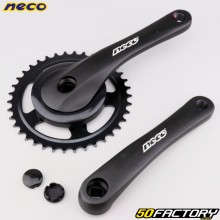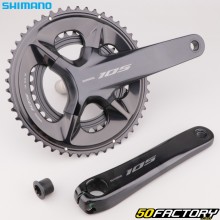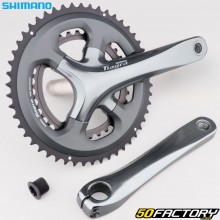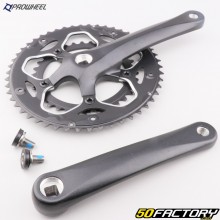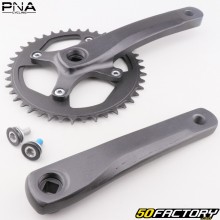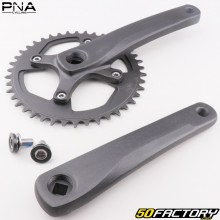 Crankset
Crankset
- IN STOCK3€40
- IN STOCK29€70
- IN STOCK178€30
- IN STOCK133€50
- STOCK EXHAUSTED26€80
- STOCK EXHAUSTED49€90
- IN STOCK-16% 323,50 € 271€74
- IN STOCK-16% 323,50 € 271€74
- IN STOCK49€90
- IN STOCK62€00
- IN STOCK62€00
Understanding the gravel and cyclo cranksetcross
What is a pedalboard?
The crankset is a transmission part located in the center of the bike, connecting the cranks and chainrings. It plays a crucial role in transmitting the cyclist's power to the bike's wheels. Specially designed for gravel and cyclo bikescross, this type of crankset is suitable for varied terrains ranging from paved roads to rough dirt roads. It is an essential component to maximize the performance of your bike, offering an unmatched combination of efficiency, durability and versatility.
His utility
This crankset is designed to offer maximum versatility, allowing riders to tackle a variety of terrains without compromising performance. Whether you're climbing a steep hill or descending a technical trail, the crankset ensures smooth and efficient power transmission. This makes it a great choice for riders looking for a crankset that can adapt to different situations, while still offering exceptional durability and reliability.
Understanding its design
The unique bottom bracket design reduces weight while increasing torsional strength, resulting inar more efficient power transmission. The chainrings, smaller than those of traditional road cranksets, offer a range of gears adapted to the rough terrain typical of gravel and cyclocross.
How to choose your pedalboard
According to your needs
Choosing the right crankset for a gravel or cyclo bikecross depends largely on your specific needs. If you are a recreational cyclist, a mid-range model might suffice. On the other hand, for competitors or regular cyclists, a high-end model offering better performance and durability will be more suitable. It is also important to consider the weight of the crankset, the ease of installation and maintenance, as well as customization options, such as the number of teeth on the chainrings.
Depending on your usage
It is also crucial to consider what you will be using it for. If you plan on doing a lot of cyclo racingcross, opt for a lightweight and robust crankset. For gravel, choose a model that offers great versatility and resistance to varied conditions. Also, take into account the typical weather conditions in your region. Par For example, for wet areas, a crankset with good corrosion resistance would be a wise choice.
Depending on your budget
Finally, your budget is a determining factor in choosing your crankset. There is a wide range of prices, and it is essential to find a model that offers good value for money, without compromising on performance and durability.
Installation
Preparing for installation
Before installing a crankset on your gravel or cyclocross, make sure you have all the necessary tools: torque wrench, crank extractor, bearing grease, etc. Also check the compatibility of the crankset with your frame and bottom bracket. Remember that each bike is unique and the choice of crankset must be made according to its characteristics. It is also important to know the size and type of your bottom bracket to choose the right crankset.
Installation steps
Installing a pedal board is done in several steps:
- Disassemble the old pedal board: Use a crank extractor to remove the crank arms and existing bottom bracket.
- Prepare the bottom bracket: Clean the housing thoroughly and apply a thin coat of grease to ensure a smooth installation.
- Install the new crankset: Follow the manufacturer's instructions for securing cranks and chainrings. Use a torque wrench to tighten bolts to specifications.
- Check alignment: Make sure the crankset turns freely and is aligned correctly with the chain.
Once the installation is complete, it is advisable to do a test drive to check that everything is working properly. If you hear strange noises or feel unusual resistance when pedaling, the crankset may not be installed correctly. In this case, do not hesitate to consult a professional.
Care instructions
Tips for optimal maintenance
To ensure the longevity of your pedalboard, regular maintenance is essential. Here are some tips:
- Regular cleaning: After each ride, clean the crankset to remove mud and debris that could damage the bearings and chainrings.
- Lubrication: Apply grease to bearings and pivot points to ensure smooth operation.
- Inspection: Regularly check the condition of the chainrings and cranks for signs of wear or damage.
Suitable tools for effective maintenance
Proper maintenance of your crankset also requires the use of proper tools. Opt for a stiff-bristled brush for cleaning, a quality lubricant for lubrication, and a chain inspector for inspection. These tools will help you keep your crankset in top condition.








